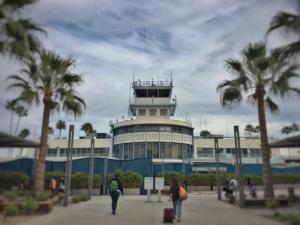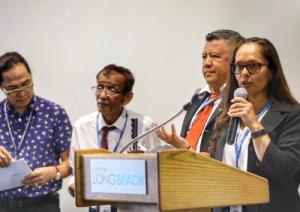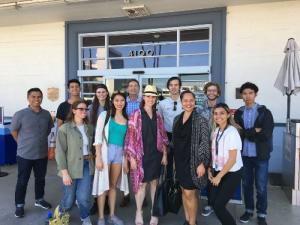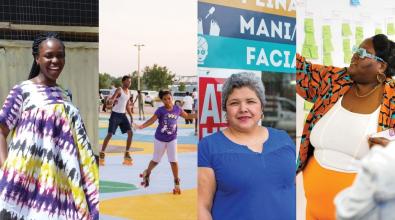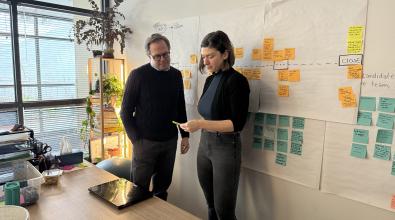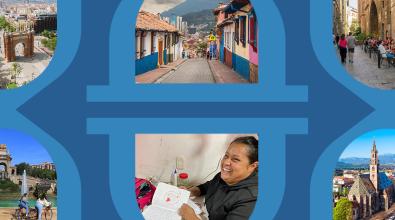In Long Beach, a business model to keep innovation cooking
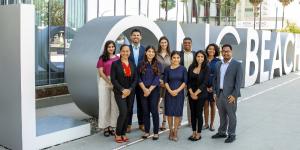
The city-run airport in Long Beach, Calif., regularly turns up on “best airports” lists and scores high on Yelp, and it’s easy to see why: It’s small and easy to navigate, with a laid-back open-air courtyard, tasty food options, and even roving therapy dogs to cheer up stressed-out travelers.
While airport leaders are used to hearing positive feedback from customers, it’s largely come anecdotally. To put more rigor behind it, they hired the city’s in-house data and design experts at the Office of Civic Innovation to develop a customer survey and train airport staff in how to conduct in-person research interviews with travelers. The result is intelligence that managers can use to serve their customers even better.
“We wanted to know where passengers are coming from, whether they’re traveling for business or leisure, whether they took an Uber or Lyft to the airport or had a friend drop them off,” said airport Administrative Officer Dale Worsham. “That’s information we didn’t have. And it’s helpful for making decisions about how we can improve — both for people coming from Long Beach and people coming from outside Long Beach.”
The airport work is one of many projects, both big and small, that the Long Beach Office of Civic Innovation has taken on since it re-launched just over a year ago. Born in 2015 as the city’s “innovation team,” with a three-year grant from Bloomberg Philanthropies, the team transitioned to a new business model intended to keep their expertise in innovation techniques around City Hall for years to come.
In the new structure, city agencies like the airport hire the Office of Civic Innovation as consultants to help them find new ways of solving problems they’re working to address. In exchange, the agencies give part of their budget — anywhere from $50,000 for smaller projects to $200,000 for big ones — to the innovation office to pay for the staff time. As cities around the world build innovation teams and offices of their own, Long Beach is showing one promising path to embedding new ways of working in local government for the long run.
‘One big puzzle’
Tracy Colunga is the driving force behind the change. When the new Office of Civic Innovation launched in October of 2018, with Colunga as its director, she likened the team to “start-up teenagers” growing into “full-fledged consultant adults.” Now, they’re becoming even more ingrained in how the city solves problems. “We have developed high performing projects that departments own and implement,” she said.
In its first year, the re-launched office took on a wide range of clients, showcasing the many ways their expertise in human-centered design, data analysis, and engaging residents as co-creators can deliver better results.
[Read our explainer on human-centered design]
They worked with the Police Department to streamline a cumbersome hiring process that loses many police recruits before they can become officers. They helped the Development Services Department find a partner to build a website that helps residents know what’s being built in their neighborhoods. And they redesigned an annual meeting meant to engage residents in the city’s budget process, turning it into an interactive workshop that, for the first time, offered ways to participate in multiple languages, including Khmer, Spanish, Tagalog, and American Sign Language.
For Colunga, one challenge is piecing together the right amount of work to keep her staff of designers, data scientists, and project managers busy but not too busy. That can be tricky because one project might require a lot of a data scientist’s time, for example, while another might require relatively little. Part of the calculus is the need to bring in enough revenue to keep the office funded and staffed for the full fiscal year. “Our budget is one big puzzle,” Colunga said.
The puzzling begins in February, when Colunga puts out a call for projects to department directors, asking them to pitch problems where her team’s innovation skills could help. The team whittles that list for input from the city manager, who is Colunga’s boss, and then accepts a number of projects by April.
The next few months are spent refining and scoping the work. That’s necessary so that Colunga can figure out what staff are needed when and the departments can pencil the work into their budgets, which the city council approves in September. By the time the new fiscal year begins each October 1, Colunga’s team is wrapping up the previous year’s projects and getting started on the next.
[Read: How Long Beach prototyped a park]
All of this, Colunga has found, requires flexibility. After going through this process with agencies this year, for example, the city manager, mayor, and council all agreed that tackling homelessness needed to be a major focus of the team’s time. Colunga reworked her staffing plan and partnered with Teresa Chandler, a homelessness expert who’s just joined the city manager’s office to lead the city’s overall efforts on the problem, to scope out where the innovation office’s services can help the most.
Colunga also has mastered how to be flexible about staffing, which isn’t easy to do in the public sector. She does this, in part, by hiring some staff on a contract basis so that their time can ramp up or down as needed. She also taps into the university community. Her lead designer, Heather Barker, teaches at the local branch of California State University, and often brings in teams of design students to help with research. Colunga also brought a master’s student of anthropology into the team, an addition that added a new perspective to the team’s research; she’s now weighing whether the city should have a full-time or contract anthropologist more fully integrated into the staff.
The team has formed something of a talent pipeline for city agencies. Colunga’s predecessor as head of the innovation team, John Keisler, now leads the city’s economic development operation. And Alma Castro, formerly the team’s deputy director, now manages the city’s Justice Lab, a cross-department collaboration hatched from the team’s work on breaking the cycle of incarceration for residents who frequently come into contact with the criminal justice system. “We develop high performing employees,” Colunga said, who “go on to work in departments to sustain innovation during the implementation phase.”
In-house flexibility
All of these team skills came to bear on the airport project. Airport leaders had a specific challenge in mind when they hired the Office of Civic Innovation. They’d worked hard over the years to build a good reputation with travelers, and with a major construction project looming, they wanted to be sure to keep it. To know how they were doing — before, during, and after the construction — they needed data.
“A lot of what was known about the customer experience at the airport was anecdotal,” said Steven Chaparro, a design strategist for the innovation office who worked on developing the airport’s customer survey. “Previously, the metrics were about how often or how high the airport landed on those ‘top 10’ lists. We realized we needed a better way to define and measure that customer experience, not only so they can maintain what they have now but also so they can find ways to make it even better moving forward.”
Chaparro worked with airport managers to determine which 15 questions to ask travelers, and to make the survey a face-to-face interaction rather than a more transactional task passengers have to do to get free WiFi. In practice, this meant airport staff and volunteers, along with Colunga’s staff and Barker’s design students walking around the terminal, chatting with hundreds of travelers, and inputting their answers into iPads. For the first round, they set out to interview 160 people. They ended up with 247.
[Read: How to make innovation capacity stick for the long haul]
The airport could have contracted outside government for survey tools, Worsham said, but working with City Hall’s in-house team cost a lot less and gave airport officials more input in the process.
“We didn’t want to give up the process to an outside consultant who would charge us a couple hundred thousand dollars,” Worsham said. “Working with the i-team, we were able to design the survey specifically to our needs. And we’ve been able to make it even better by improving the questions, the locations where we do the survey, and the time of day when we do it. We were able to do all of that a lot quicker going through the Office of Civic Innovation than if we went outside.”
The airport is tapping into the Office of Civic Innovation in other ways, as well. Barker and her design students looked at the entire customer journey for travelers, from the time they leave for the airport, through checking in, security, grabbing a cup of coffee, and boarding the plane — as well as the journey in reverse for arriving passengers. They produced a detailed customer experience guide. It assesses points along those journeys where customers currently have negative and positive experiences that airport leaders could improve over time with targeted initiatives.
“The customer experience starts before you get to the airport,” Barker said, noting that Long Beach Airport competes against others in the region, most notably Los Angeles International, or LAX. “Long Beach is almost always a little more expensive, so how can I as a customer find out immediately that it’s worth it?”
In the coming year, Worsham said, the airport hopes the Office of Civic Innovation can help vet the endless array of new technologies that promise to help airport leaders with things like monitoring passenger movements to see where people wind up in queues. He’s not sure where those investigations will end up, but he’s sure the airport has a strong ally in the effort.
“Tracy has that mentality where she really wants to see the city succeed and she’s really there to help departments like us,” Worsham said. “The Office of Civic Innovation — they have ‘innovation’ in their name. They’re not just providing a service. They’re invested in the success of the departments.”
